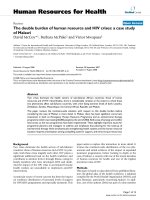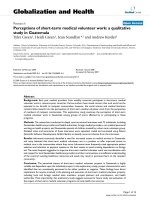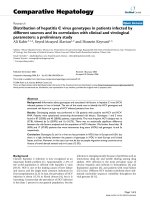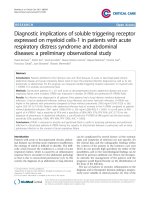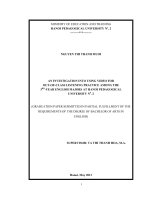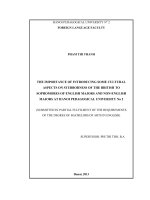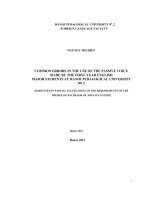1 ST year students’ perceptions of extensive reading and learner autonomy: A preliminary study at Hanoi Pedagogical University number 21 - Trường Đại học Công nghiệp Thực phẩm Tp. Hồ Chí Minh
Bạn đang xem bản rút gọn của tài liệu. Xem và tải ngay bản đầy đủ của tài liệu tại đây (418.42 KB, 7 trang )
<span class='text_page_counter'>(1)</span><div class='page_container' data-page=1>
174
TRƯỜNG ĐẠI HỌC THỦĐÔ HÀ NỘI<b>1</b>
<b>ST</b><b> YEAR STUDENTS’ PERCEPTIONS OF </b>
<b>EXTENSIVE READING AND LEARNER AUTONOMY: </b>
<b>A PRELIMINARY STUDY AT HANOI PEDAGOGICAL </b>
<b>UNIVERSITY NUMBER 2</b>
<b>1</b><b>Đỗ Thu Hoà </b>
<i>Trường Đại học Sư phạm Hà Nội </i>
<i><b>Abstract: Extensive reading has been increasingly applied in the process of teaching and </b></i>
<i>learning, especially in the field of language teaching. However, it seems that little </i>
<i>research has been done on extensive reading and learner autonomy, an area that many </i>
<i>Vietnamese learners need to develop. This study was conducted to examine the </i>
<i>perceptions of students at Hanoi Pedagogical University No.2 (HPU2) of extensive </i>
<i>reading and learner autonomy as the first step of collecting information for a deeper </i>
<i>investigation on the impacts of extensive reading on fostering learner autonomy. To </i>
<i>achieve the objective, a questionnaire was sent among 178 first year non- English </i>
<i>majored students. The findings showed that 1) students had no or little experience in </i>
<i>practicing extensive reading, and 2) students were not really autonomous in their </i>
<i>learning. Therefore, to develop students’ autonomy, the teachers should integrate </i>
<i>extensive reading, especially reading in English into the teaching activities properly to </i>
<i>exploit its advantages on enhancing learner autonomy. </i>
<i><b>Keywords: extensive reading; learner autonomy; non-English majored students; HPU2 </b></i>
Nhận bài ngày 20.4.2020; gửi phản biện và duyệt đăng ngày 15.5.2020
Liên hệ tác giả: Đỗ Thu Hòa; Email:
<b>1.</b> <b>INTRODUCTION </b>
In the process of globalization and integration, English has become a compulsory and
important tool for the communication of almost every daily activity. Being aware of the
importance of English, The Ministry of Education and Training of Vietnam has invested
huge amounts of money and effort in developing English language learning and improving
1<sub>This research was funded by the Science and Technology Research Fund of Hanoi Pedagogical University </sub>
</div>
<span class='text_page_counter'>(2)</span><div class='page_container' data-page=2>
TẠP CHÍ KHOA HỌC − SỐ 40/2020 175
the national standard of English, which are demonstrated through the implementation of
the National Foreign Language Project or Project 2020. Nevertheless, despite the strong
determination of learning and teaching English, it is not easy for every learner to acquire
English, especially due to the long practice of traditional teaching methods that are widely
used in the secondary and high school level. This way of teaching mainly focuses on
building up grammatical and written ability for students to prepare for and to pass the
national examination to enter the university. According to the research results taken by the
Ministry of Education and Training, because of the exam-driven teaching method, which
are often designed to be split 40% for teacher explication, 50% for study and memorization
and only 10% for practice (Nguyen, 2013), after 9 to 12 years of learning English, the
students have had the habit of following the teacher’s instructions in the class and even
outside the classroom and they can barely communicate in English.
Resulted from the habit of learning at the lower levels, it takes students much time to
change themselves to get used to the new teaching and learning style when entering
university. This is due to the reason that once students enter the university, they are in a
freer and more independent environment, in which most of activities are now being taught
and implemented under the learner-center approach, which requires much of their effort
and investment in self-studying. The teacher is no longer the king and the queen of the
class, who gives out the order for the students to follow, but the one who provides
orientation and support for them when necessary in order to achieve the academic learning
goals set up by the institute. The students are now the ones who make decision on the way
to acquire knowledge based on the guidance of the teacher and the established academic
schedule.
In order to achieve good results of learning, it is necessary for the students to be
capable of knowing and being skilled at learning on their own, or on autonomous learning,
which demonstrates through their time management for learning and other activities, goal
setting, and goal achieving. However, as it has been said before, since from the lower
levels of education, students were used to learning under the instructions of teachers most
of the time, it is really a challenge for them to start studying on their own immediately.
Consequently, there are many cases that one student invests a big amount of time on her or
his studying but the results are still not as good as she or he expects. This, through a period
of time, will demotivate the student from learning. So, the question that students and even
teachers at university must focus on is to build up learner autonomy, one of the key factors
to decide the success of a language learner. Research shows that extensive reading could be
one of the ways to help students become interested in what they read and more important,
it could help students to develop their learner autonomy (Imrie, 2007; Takase, 2008).
</div>
<span class='text_page_counter'>(3)</span><div class='page_container' data-page=3>
176
TRƯỜNG ĐẠI HỌC THỦĐÔ HÀ NỘI<i>* Definition of Extensive Reading </i>
Extensive reading is a familiar term in the field of teaching and learning language as it
has been studied by many linguists in this field. Extensive reading, or more precisely the
term “extensively”, is first mentioned by Harold Palmer (1963, as cited in Sheu, 2004)
when he compares it to intensive reading. Bright & McGregol (1977) describes extensive
reading as “reading a quantity of FL/L2 materials over a certain length of time” (as cited in
Sheu, 2004, p.214) in order to achieve the general understanding. Sharing similar opinion,
Iwahori (2008) defines extensive reading as a way of giving L2 instructions of reading,
which the goal is to allow learners to cover a large amount of reading texts that are of their
enjoyment. Many more lingual researchers have also looked deeply into the
language-teaching-related side of extensive reading and terming it with some names that reflect its
pedagogical aspects. Bamford and Day (2004) calls it “a language teaching procedure” to
help learners to get the global general understanding, while Iwahori (2008) refers to it as a
L2 reading instruction, the goal of which is to let learners come through a big quantity of
reading materials that appeal to them.
All in all, in the viewpoints of Bamford and Day (2004), and Hedge (2000), the typical
features of extensive reading when being employed as a teaching and learning program
include: a) the connection to a great variety of reading materials; b) the chance of reading a
large number of texts; c) the freedom to select whatever books to read; d) the ability to read
at individual speed; e) the pressure-free environment; and f) the opportunity to practice
real-life reading.
<i>* The Benefits of Extensive Reading </i>
With its unique characteristics, extensive reading demonstrates valuable benefits to the
process of language learning such as the vocabulary acquisition, the language proficiency,
and especially the learner autonomy showing in the change in the reading attitudes, the
increase of the reading speed and the opportunity of practicing decision making ability.
In terms of vocabulary acquisition improvement, Rashidi and Piran (2011) affirm that
extensive reading helps students gain considerate amount of vocabulary when practicing
extensive reading on in EFL learners at different language levels.
In addition, extensive reading is also beneficial to the enhancement of language
proficiency, especially in fostering the improvement of other language learning skills such
as writing, speaking and listening. Chen et al. (2013) exploit the benefits of e-books using
for extensive reading and conclude that extensive reading has encouraging influence on
vocabulary growth and writing skills.
</div>
<span class='text_page_counter'>(4)</span><div class='page_container' data-page=4>
TẠP CHÍ KHOA HỌC − SỐ 40/2020 177
study on the benefits of extensive reading in the EFL high school students in Japan, they
conclude that extensive reading has positive effect in motivating students to read, even
they were not really interested in reading because of their limited vocabulary and the gap
between their L1 and L2 before the research. Yamashita (2015) confirms once again the
strengths of extensive reading on promoting reading attitudes and enhancing the reading
speed through the positive results on improving reading attitude and speed in his research
with Japanese EFL learner at tertiary level. Nation (2015) emphasizes strongly that in term
of improving meaning-focused input and fluency ability, extensive reading really fits into
the principle of a well-balancing language course.
In brief, extensive reading possesses many advantages in fostering the language
proficiency, the vocabulary acquisition for the learners. Moreover, it also proves its
strengths in developing and enhancing learner autonomy, showing through the increase of
reading speed, the change in reading attitudes and the ability of making decision among the
learners.
<i><b>2.1.2. Learner Autonomy </b></i>
<i>* What is learner autonomy? </i>
</div>
<span class='text_page_counter'>(5)</span><div class='page_container' data-page=5>
178
TRƯỜNG ĐẠI HỌC THỦĐÔ HÀ NỘIit must be acquired through both ways: naturally or trained (Holec, 1981).
<i>* Why is learner autonomy important? </i>
According to many empirical studies, autonomy – feeling free and willing in one’s
actions is a basic need of human. In formal educational contexts, learner autonomy entails
reflective involvement in planning, implementing, monitoring and evaluating learning. But
as language learning depends crucially on language use, we can learn to speak only by
speaking, to read only by reading, and so on. Thus, in formal language learning, the scope
of learner autonomy is always constrained by what the learner can do in the target
language. In other words, the scope of language learner autonomy is partly a function of
the scope of our autonomy as target language users. (Thomas et al. 2015). The
development of autonomy in language learning is governed by three basic pedagogical
principles: 1) learner involvement – engaging learners to share responsibility for the
learning process (the affective and the metacognitive dimensions); 2) learner reflection –
helping learners to think critically when they plan, monitor and evaluate their learning (the
metacognitive dimensions); 3) appropriate target language use – using the target language
as the principal medium of language learning (the communicative and the metacognitive
dimensions) (Holec, 1981)
<i><b>2.1.3. Extensive reading and learner autonomy </b></i>
Research shows that extensive reading and learner autonomy have the positive
correlational relationship (Imrie, 2007; Takase, 2008). Extensive reading could help
students to develop learner autonomy as it encourages the autonomous learning of a
language learner, changes their learning habits, and promotes learner’s learning motivation
(Lee, Schallert & Kim, 2015; Imrie, 2007; Takase, 2008; Yamashita, 2015).
Studying about the effects of extensive reading on learner autonomy, Matsubara and
Lehtinen (2007) concluded that extensive reading helped the learners change their attitudes
toward learning process, or more precisely, toward the activity of reading in L2. Through
the data collected from the questionnaire and journals kept by the EFL students at Kanda
university during two semesters, Matsubara and Lehtinen (2007) found the extensive
evidence of the change in students’ attitudes toward their autonomous learning
development. This is in line with many other studies such as Lee, Schallert and Kim (2015)
and Yamashita (2015).
</div>
<span class='text_page_counter'>(6)</span><div class='page_container' data-page=6>
TẠP CHÍ KHOA HỌC − SỐ 40/2020 179
sense of having the power over their learning activity, which is typically an autonomous
learning activity.
To conclude, the nature of extensive reading seems to possess many positive and
beneficial things that can create good condition for learner autonomy to be shaped and
enhanced as doing extensive reading will provide freedom and space for the learners to
make choices, to arrange the activity under their own decision and to help them become
more responsible with their activity. Therefore, a survey was conducted in order to initially
find out the perceptions and experience of the 1st<sub> year non-English majored students at </sub>
HPU2 in extensive reading and learner autonomy.
<b>2.2. Research </b>
<i><b>2.2.1. Research setting and method </b></i>
The research study was carried out in four non-English majored classes at Hanoi
Pedagogical University No.2 (HPU2) with the number of 178 students, who have just
passed their entrance examination into the university. Among these 178 students, 11 are
male and 166 are female. They are all have at least 7 years of learning English at lower
levels of education. At the time joining the study, their English is supposed to be at
pre-intermediate level, with very basic English knowledge of grammar, vocabulary, and four
macro skills.
In order to investigate whether the students were autonomous in learning as well as to
confirm their experience in extensive reading, Questionnaire was employed as the data
collection instrument with two main parts. The first part consisting of 12 questions aimed
at finding out whether the students had experience of extensive reading or not. The second
part was to discover about students’ autonomy in learning with 12 questions focusing on
the aspects of learner autonomy. In this research, the questionnaire was sent to students
directly to collect data on their reading experience and learner autonomy. Furthermore, to
help students avoid misunderstanding the questions as their English level was just at
beginner level, the questionnaire was made in Vietnamese.
<i><b>2.2.2. Findings </b></i>
Data from the questionnaire confirmed the problem of lack of learner autonomy and
extensive reading experience, thus providing a need for conducting a further research
project on the influences of extensive reading on learner autonomy. Data from
questionnaire revealed that the students did not have learner autonomy in their learning,
especially in reading. Another problem that the students had little experience with the
activity of reading extensively was also affirmed. The sections that follow will detail these
findings.
<i><b>2.2.3. Lack of Experience in Extensive Reading </b></i>
</div>
<span class='text_page_counter'>(7)</span><div class='page_container' data-page=7>
180
TRƯỜNG ĐẠI HỌC THỦĐÔ HÀ NỘIinformation on students’ prior experience with extensive reading. It revealed that students
seldom read extensively in the learning process. Generally, despite the fact that the
participants were well aware of reading importance, they still had passive attitudes towards
reading and little experience with the activity of reading extensively.
Students showed their awareness of the significance of reading from question 1 to
question 5. Students appraised such strengths of reading as broadening the knowledge,
developing proficiency with the dominant selection of option Agree and Totally Agree
ranging from 56.8 % to 93% collectively for each question. Nevertheless, students’ passive
attitudes and inexperience of extensive reading were also expressed from question number
8 to question 12. It can be seen that 67 % of students disagreed or confused when being
asked that they had responsibility or they could choose their own reading way. In addition,
all participants dissented from the idea that they could read well without teachers’ help.
Moreover, 66 % of participants revealed that they did not often read at home when they
were not required. Only 2.5 % claimed that they were interested in being able to read texts
for studying in other fields. Figure 1 demonstrates the result of the first part of the
questionnaire.
<i><b>Figure 1: Students’ opinions on extensive reading </b></i>
<i><b>2.2.3. Lack of Learner Autonomy </b></i>
Questionnaire data indicate that there was a lack of learner autonomy among students
in their learning, especially reading. This problem was demonstrated in the fact that when
being asked about their practice of autonomy in the second part of the questionnaire, the
majority of the participants chose option sometimes for most questions.
</div>
<!--links-->

